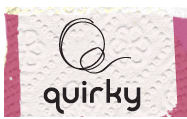The Internet has allowed isolated individuals to expand from their local perspective and sell products all over the world. If you have stuff to sell, then you can use eBay as your online marketplace, with some 88 million active users. Or if you're a crafter type, you can use Etsy to sell handmade goods (see previous post). And small entrepreneurs can build a business through persistent development of clever product concepts (see previous post).
But what if you're more the creative idea type, with concepts for possibly interesting products, but without the support system required to develop, produce, and market them?
 That's the idea behind Quirky, the social network site for product concepts. You bring the idea, the crowd-sourced community rates it and helps develop it, and then Quirky can bring it to market -- paying you a royalty stream from the sales.
That's the idea behind Quirky, the social network site for product concepts. You bring the idea, the crowd-sourced community rates it and helps develop it, and then Quirky can bring it to market -- paying you a royalty stream from the sales.
Admittedly, these are not fancy creations -- they must be able to be sold at retail for under $150, and cannot contain complex electronics. Most Quirky products are relatively simple but clever and useful accessories for home and personal electronics.
 For example, the DigiDudes is a portable camera tripod with retractable legs that collapses and then screws into a bell-like holder (decorated as funky dude), with a keychain to hang on your bag or belt ($24).
For example, the DigiDudes is a portable camera tripod with retractable legs that collapses and then screws into a bell-like holder (decorated as funky dude), with a keychain to hang on your bag or belt ($24).
And the Split Stick is double-sided USB drive so you can store personal and public data separately on the same device ($24).
You begin the process by submitting your idea, typically with some sketches, and pay a $99 fee. At worst, even if the idea does not get into production, you will receive feedback from the community on your idea, along with some market research support.
The real power here, however, here comes from incentivizing everyone involved (much like the successful MIT Red Balloon team for the DARPA Network Challenge). All the people involved in the development of the product are allocated percentages of the royalty stream, based on their contributions through the key elements of the process: tagline, logo design, product naming, industrial design, and product research.
The packaging for each product then includes a credit to the inventor, with photo, and a fold-out panel that lists the many contributors.
Quirky goes through the process of choosing a new product to develop each week. The site currently lists 6 products available for sale, 18 products in production and available for pre-sale, plus 5 products in the development pipeline.
More on Royalties and Open Development ...
The Quirky royalty is paid off the top, as 30% of the top line product revenue. The original inventor is allocated a healthy 40% of the royalty stream, and more depending on their further involvement. A few other major contributors may receive single-digit percentages, around 5% to 10%. And these products also may have several hundred other people involved in the development, each then sharing more like 0.1%.
For example, for the $25 DigiDudes product, the inventor receives 49% / $3.67 per unit, and the major contributor 8.4% / $0.63, while for the $15 PowerCurl, the inventor share is 38% / $1.71, and the major contributor is 6.2% / $0.28.
This open development approach is an interesting contrast to a more typical business focus on intellectual property, protecting ideas, and legalisms like non-disclosure agreements. With Quirky, you submit your idea in the open, so it's possible that someone else may "steal" it -- or, more likely, the idea is not totally unique, and others have been thinking about related concepts.
Instead, with Quirky, you then hopefully benefit from the collaborative process of brainstorming and developing the idea -- you can even let it go at this point and let others get it to market while you collect the royalties. Or you can change your mind and decide to develop the product on your own, since you don't need to sign away your rights when you submit it. (Of course, as the product gets in production Quirky then needs to patent it as required.)
